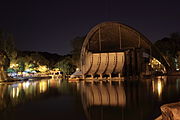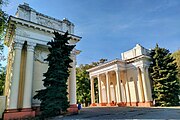Lazar Hloba Park
| Lazar Hloba Park | |
|---|---|
| Парк Лазаря Глоби | |
 City pond at the park | |
 | |
| Type | Urban park |
| Location | Dnipro Raion |
| Nearest city | Dnipro |
| Coordinates | 48°28′15″N 35°01′41″E / 48.4708929°N 35.0280756°E |
| Area | 26 hectares (64 acres) |
| Established | 1807 |
| Etymology | Lazar Hloba |
| Operated by | Dnipro City Council |
| Status | culture and recreational park |
The Lazar Hloba Park (Ukrainian: Парк Лазаря Глоби, romanized: Park Lazarya Hloby) is one of the oldest and largest central park in the city of Dnipro, Ukraine.[1] Established in 1807, the park bears the name Lazar Hloba in honor of the Cossack.[2][3]
History
[edit]The park's history dates back to Katerynoslav's founding. Cossack Lazar Hloba established the park, which was then a garden. He chose to settle here after his military service ended in 1743 because he had a fascination with the scenic areas along the Dnieper. Gardening was his passion, thus after relocating, he planted several gardens and constructed four watermills alongside the river.[4]
The upper garden on the riverbank was the first location Hloba relocated. He was quite pleased of the several beautiful trees and flowers he planted in Dnipro, which is now Taras Shevchenko Park.[5] However, Grigory Potemkin quickly purchased this property for the purpose of building his home (Potemkin Palace) but was never completed,[6] and creating a new park and garden area around it. As a result, Hloba moves to live on the land that was formerly his lower allotment, becoming the present day location.[4]
Hloba extended the lowland garden to the future Sadovaya Street (now St. Andriy Fabra), from the lake that once stood where the Ozerka market now stands. He only spent around ten years here before passing away at the age of 104, in 1793.[5] Following his passing, the garden was given to a canvas manufacturer on its western edge,[7] renamed as the Katerynoslav State Botanical Garden.[4]
In 1806, Novorossiysk needed unique trees and plants for fruit plantations, so Emperor Alexander I ordered Governor Duke of Richelieu to supply the top garden in Ekaterinoslav for public celebrations and the lower garden to be returned for regular landscaping.[5] The park, at the time covered more than 40 hectares (99 acres), has been given new life since 1807 thanks to the efforts of chief gardener Adam Hummel, who also helped to establish a Special Pomological Committee for gardening.[7] This leads to the founding of the gardening school in the northern part of the garden in 1817.[4]
Under the permanent leadership of General Ivan Nikitich Inzov, the committee operated until 1843. The garden's species collection grows throughout this time, reaching 945 plant genera in 1837, and 20,000 seedlings are sold annually. The park and the Poltava School of Horticulture were included under the newly established Ministry of State Property in 1837. Though the school that served as its foundation lasted until 1858, the Katerynoslav Botanical Garden is progressively deteriorating since the death of its founder in 1848.[7]
AIn 1869, the Treasury Garden was renamed the City Garden. For this reason, the western portion was divided and made inaccessible to the public in 1895, becoming the Technical Garden, while the remaining portion remained urban and open to all visitors.[5] The technical section was leased, research spaces and greenhouses remained, and a gardening school reopened. A tiny lake inside the park's boundaries grew during the 1800s as a result of water from the nearby lake freezing over at the location of the present-day Lake Market.[4]
On the reclaimed portions of the garden and the Lutheran Church, a Catholic Church was constructed in the 1860s and 1870s. The English Club was leased by the City Garden in the start of the 1800s, and a summer theater was constructed on the club's location in 1904. The garden, which was normally peaceful, became the scene of protests and demonstrations during the 1905 revolution. Thousands of laborers and soldiers gathered here on 19 October 1905. On the site of the park, which is now the Dnipro Academic Drama and Comedy Theater, Winter Theater was constructed in 1907.[4]

A new street named Nova was created during the park's subsequent rebuilding from 1924 to 1930,[5] which extended from Starokozatska Street to the present-day Avenue D. Yavornytsky. This resulted in a pedestrian bridge being built across the lake in the 1930s. Following the park's destruction during the Russian Civil War, the park's reconstruction got underway in the 1930s.[4] Following the founding of Mendel Khatayevich's regional communist party in the city in 1934, the park was renamed the Khatayevich Central Park of Culture and Recreation in his honor.[8] In commemoration of Valery Chkalov, the park was renamed following Khatayevich's capture and death in 1937.[9]
Newspapers from December 1935 stated that the pioneers of the spawn-in school and the Komsomol inhabitants of the locomotive repair factory sought to construct a children's railway in the city together. Thus, work started on 2 April 1936, and the 2 kilometres (1.2 mi)[7] railway was opened on 6 July.[5] Nazi Germans are said to have carefully disassembled the railway equipment during World War II and planned to transport it to Germany.[7] In 1947, the railway had a thorough restoration.[4]
A fountain with a sculpture of Samson was perhaps the park's major draw, as images from the 1950s and 1960s inevitably showed. After the war, in the middle of the 20th century, it was installed. The Lazar Hlobe obelisk-memorial was taken down in 1936 to make room for the Children's Railway, and a replacement monument wasn't placed there until 1972.[7] He paints a picture of him clutching a little piece of wood.[4] It was not until 1992, the park was given it's present day name Lazar Hloba Park.[7]
An explosion was heard on 27 April 2012, at 12:45 outside the park's main entrance on Dmytro Yavornytskyi Avenue (formerly Karl Marx Avenue). This was the third explosion in a string of terrorist strikes. Three persons were injured, one of whom required hospitalization.[10] The Dnipro City Council decided to name the pedestrian lane in Hloba Park in honor of John Paul II on 17 August 2022.[11]
Landmarks and structures
[edit]Playgrounds, a racing center, a children's train, and various areas for strolling and leisure are all present. In the middle of the park, an artificial lake has been built. A scene shaped like a seashell is decorated in one of the park's ends. There's a summer theater and several activities around the lake.[12] Swans and ducks may be seen on the lake, and during the warm season, catamarans can be ridden on it.[3] Other places of interest within the park includes:[7]
- Monument of Valery Chkalov – the current bronze monument replaced the first one that first appeared in the park in 1957.
- Monument of Lazar Hloba – a symbol of the park and a tribute to its founder.
- Dnipro Dolphinarium – the park's dolphinarium since 2009.[2]
- Children's Railway – a children's narrow-gauge railway built in 1936.
Gallery
[edit]-
Children's Railway in 2006
-
Summer Theatre at night in 2012
-
The park's lake in autumn, 2017
-
Monument of Lazar Hloba in 2015
-
The park's main entrance in 2023
References
[edit]- ^ "Парк имени Лазаря Глобы, Днепр". UA.IGotoWorld.com (in Ukrainian). Retrieved 19 March 2024.
- ^ a b "Парк імені Лазаря Глоби". travel-guide.in.ua (in Ukrainian). Retrieved 19 March 2024.
- ^ a b "Парк им. Лазаря Глобы | Дети в городе Днепр". Парк им. Лазаря Глобы | Дети в городе Днепр (in Ukrainian). Retrieved 19 March 2024.
- ^ a b c d e f g h i "Парк Лазаря Глоби – центр розваг і веселощів міста…". www.dnipro.libr.dp.ua (in Ukrainian). Retrieved 19 March 2024.
- ^ a b c d e f "История самого старого парка Днепропетровска". 056.ua – Сайт міста Дніпра (in Ukrainian). Retrieved 19 March 2024.
- ^ "Самотній Кучма і Лазар Глоба серед руїни – - Україна Молода". www.umoloda.kiev.ua (in Ukrainian). 5 February 2017. Archived from the original on 5 February 2017. Retrieved 19 March 2024.
- ^ a b c d e f g h "Парк Лазаря Глоби у Дніпрі". zabytki.in.ua (in Ukrainian). Retrieved 19 March 2024.
- ^ "«КАДРЫ РЕШАЮТ ВСЕ!» Эпизод из истории Днепропетровска сталинской эпохи. (Город и люди)". www.realnest.com.ua (in Ukrainian). 31 May 2006. Archived from the original on 18 May 2008. Retrieved 19 March 2024.
- ^ "Парк Лазаря Глоби – центр розваг і веселощів міста…". www.dnipro.libr.dp.ua (in Ukrainian). 31 January 2019. Archived from the original on 31 January 2019. Retrieved 19 March 2024.
- ^ "Міністр юстиції: підстав для введення надзвичайного стану в Україні немає". BBC News Україна (in Ukrainian). 27 April 2012. Retrieved 19 March 2024.
- ^ "У відомому парку Дніпра пішохідну алею назвали на честь Папи Римського – Днепр Инфо". Днепр Инфо – Новости Днепра (in Ukrainian). 17 August 2022. Retrieved 19 March 2024.
- ^ "Глоби Лазаря ім. парк". gorod.dp.ua (in Ukrainian). Retrieved 19 March 2024.





